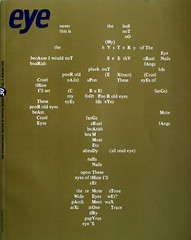Winter 1998
Live die eat cheat
Behind the screen is a world where bullets and bodies defy mortality and gravity. A visual history of computer games from kindergarten to carnage
As someone who was brought up on a diet of television, corporate sponsorship, Thatcherism and 1980s trash in general, I realise that my generation has been the first to witness first-hand the birth, growth, and subsequent world domination of the computer game. From the early arcade adventures with the blocky graphics of Space Invaders, or Defender, to identifying with the first virtual celebrity in the shape of Pac-Man with his ever increasing appetite for ghosts and small blue pixels, or just trying to get that elusive backspin in the minimalist Pong, these early arcade and console games relied almost exclusively upon the ‘gameness’ of the experience itself.
In one sense a computer game is just a toy, but what it really presents is virtual space. Right back from the first moment that you played Pong, you were not really sitting there thinking ‘Wow, I’ve always wanted to play simulated ping-pong’, it was a fascination with being able to physically control the pixels on the monitor – their behaviour, their reactions, and their consequences. Pong, for example, deals with a particularly relevant sense of virtual space: play without gravity. You immediately notice that the ball behaves differently to any ball you have ever come across before in the so-called real world. Douglas Rushkoff, author of Children of Chaos, interestingly expounds on this point by suggesting that whereas before computer games, most play had to do with some form of defiance of gravity, which he equates to the scheme of Aristotle’s Poetics – you build something up to a climax and then fall away – the real revelation of computer games was that within their virtual spaces, all the known physics of the world can be altered – it is a technology that can bend our parameters of the perceptible world.
Be that as it may, the vast majority of gaming scenarios embedded in computer games still emulate the perennial struggle between good and evil, between man and the technology he creates – a strong parallel, of course, to the Frankenstein myth, that in recent times has evolved into the myth of the humanoid computer. The unfathomable aspect of computers, whose workings are even less imaginable than that of Frankenstein’s sampling of real body parts, enhances the idea of remoteness, and therefore unease. You don’t know how it works, but you know that it works – and it could work against you. More so – unlike Frankenstein’s creation – it could outwit you.
The cinema has played a substantial role in proliferating this myth of the computer gone crazy. We need only think of those great 1950s science fiction B-movies such as Terror from the Year 5000, through to the HAL9000 and his conflict of interests in Stanley Kubrick’s 1968 masterwork 2001 – A Space Odyssey, or even as far back as the city-controlling supercomputer in Fritz Lang’s Metropolis (1926), which provided the template for dozens of subsequent Hollywood robots. The unseen processing force is given metallic human form, but importantly, is not of our flesh. Hollywood computers or robots, and particularly in 2001, are imbued with some kind of intelligence, either artificial or otherwise, which, when placed into a highly technological context, becomes existentially threatening.
Screen shots from early 1980s arcade game Space Invaders. The player must protect fragile gunships from alien invasion. The challenge of this blocky arcade defence game was seeing how long you could last rather than racking up a giant score. Once the level had been completed, another wave of aggressors was waiting to have its turn.
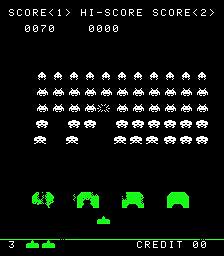
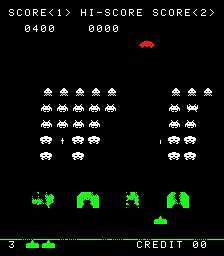
Grandmaster flash
The HAL9000 computer in 2001 is designed (apart from its duties controlling the ship’s day-to-day activities) to play chess with the Discovery’s crew, as is IBM’s more recent Deep Blue project – a chess playing supercomputer capable of an astonishing number of calculations per second, which has, over the last few years, been sparring with the Russian grandmaster Garry Kasparov. HAL, however, is programmed, as we are told, to lose 50 per cent of the time, thus allowing the player to think that the computer is beatable. Yet when it is (and is not) beatable is randomly generated, and the player never knows this, nor can he possibly predict it – an essential aspect of play that is cynically ignored in another recent cinematic computer, in Chris Marker’s film Level Five. There, a software-generated voice flatly announces halfway into a game: ‘You have lost, but you may play on’.
Deep Blue, on the other hand, strives to win every time, using an archive of previous champions’ moves stored inside it by the IBM team. Kasparov referred to this as playing the ghosts of former grandmasters. But still Kasparov is able to beat Deep Blue at times, as I understand it, by fooling the computer into reacting to a certain set of misleading strategies. Just like Kasparov, David Bowman, the central human character in 2001 is able to outwit his technological aggressor, subsequently taking his revenge on HAL by deleting his memory.
Chess of course, is a game, and many of today’s incredibly graphically advanced games, perhaps in some way try (even indirectly) to refer back to this old visualisation of tactical warfare – precisely the aspect that makes computer game playing absolutely compelling. Different styles of games submit to differing strategies, which can include, for example, hiding, a kill or be killed scheme, stealth or search, collection and assimilation of material such as keys, potions, scrolls or whatever.
Early testing of Atari video games found that strategy became more important than pure speed of reaction in determining the eventual outcome of the game. While most games are made up of various elements of strategy, speed and tactics, it is the specific combination of these elements that allows the player to become successful – or fail. The game Pac-Man, for example, in all its multifarious formats, became simple to master for the hardened player. Route maps were a hot property for the seriously dedicated gamers of 1980.
Reality quest
Strategy changes when you begin to consider the notion of the multiplayer computer game – the mediation between two or more players using the computer as some form of central interface. It is no longer person versus computer, but very directly person against person, with the computer providing the context, means and tools, or interface, through which to play – be it in a forest, or a kung-fu temple, a subway, a castle dungeon or whatever. It is this increased idea that you are playing another person, a real person, which compounds the experience’s sense of reality. The current commercial trend for ever increasing realism, the sense of completely immersing yourself within an alternative reality (albeit still based upon the world as we know it) within games has now shown itself to be essential to a game’s technical and commercial success, showing its intimate parallels with cinema. The two areas are becoming closer and closer entwined. For example, the recent X-Files CD-ROM contains lengthy sequences of QuickTime movies (as do most introductory sequences for both home and arcade game titles), so the notion of stringing together your own narrative through simple decision making in order to create a new storyline for Mulder and Scully becomes easy to suggest. It seems that more and more ‘creative’ power is deferred onto the player, who is toying with determining the outcome of the game – chance and skill have taken a back seat to sweep and style. The notion is that of stepping into an escapist, virtual community or environment, filled with an unknown number of traps and meanies just waiting for you to drop your guard during that crucial moment of weakness. Take a game such as Messiah or Unreal. Whereas most current 3D game characters from games such as Quake for example, would be made out of 700 different digital pieces, these more advanced games can now wrap a character in a life-like flexible, stretchable skin made up of over 180,000 pieces.
Probably growing out of the arcades, this growing realism has culminated with a problematic formula for the games, in that in order for them to end, the player usually has to die. To provide a ‘sense of closure’ within these experiences, death has always been a quick and easy solution for the programmers (either that or ‘running out of time’ – which kind of equates to the same thing, but is ultimately duller than dying). This idea circulates at the very heart of the computer gaming origins – the arcades. The idea was simple – the more you die, the more money you put into the machine. This of course, with the rise of the home market, has taken a major setback. Therefore, the arcade designers have taken it upon themselves to try to make their games almost not appear like games anymore, but like a fusion of various types of cinema, usually the B-movie kind. Coupled with this is the shock notion that the player (just like the actor), has to die in ever increasingly gruesome ways. Take the bloodbath arcade House of the Dead for example. Right back from being eaten by ghosts in Pac-Man, bombed to death by aliens in Space Invaders, kicked into unconsciousness in Tekken, or mauled to death by the napalm-spitting zombies in Doom, the notion of death and rebirth has been absolutely integral to the computer game – arising out of the economic realities of the arcade, the womb of all computer games.
International carnage
Beyond the arcades, one of the most recent stages of game development on the home market takes the idea of the multiplayer game and extrapolates it one stage further. The network game (many players simultaneously joined together through computer networks, playing against each other instead of the computer) returns the idea of uneasy remoteness to computer gaming. With the network possibility, a number of different computers can be joined together, either through internal networks such as Ethernet or Local Talk, over a modem and through the telephone lines, enabling the computer game to now become a global event. The idea of having a four-player game of Doom with your ‘friends’ (which you of course hope to obliterate) in Australia, America and England is no longer a technological fantasy. Indeed, one of the fastest growing areas within the Internet deals with precisely the organisation and assimilation of interested players waiting to inflict virtual carnage upon each other.
The network games provide a simulated version of playing against the computer, yet with all the imperfections and unpredictability of a human player now thrown in. You might not even know the other player, so their presence within the game bears close similarity to what the computer would generate anyway. Indeed, in many versions of Duke Nukem 3D, there is an inbuilt ‘cheat mode’, whereby you can activate the simulated multiplayer option, which just makes the game almost impossibly hard to play. The idea though, and this returns to the tactics encountered with Deep Blue, is that the human opposition would move around in an entirely different and unpredictable way, one which the computer would never be instructed to achieve, and the players’ learning of the computer’s typical movement patterns becomes completely obsolete. This clever programming – and marketing – technique provides and secures the longevity of a game, and ensures that no two games are ever the same, or even similar, and almost removes the notion of strategic play (except for various degrees of hiding). Companies are now levering more revenue from this trend by releasing add-on packs containing additional levels and editors, in one sense empowering the player with the gift of being able to feel like a programmer, while on the other hand securing that the very same player does not stray from the game the company is selling.
As computer games become more sophisticated, with the industry turning over billions each year and pumping a lot of it back into development, certain trends are beginning to emerge. One prominent feature is how the history of computer gaming is starting to be written, and in particular within the context of contemporary developments. Dave Perry, programmer of Earthworm Jim and MDK, as well as developer of the Messiah engine, explains that: ‘It’s kind of funny, because the video game business is so young, everyone that started it is still alive, it’s literally, like, fifteen years old?’ What is surprising is how, just like any other notion of historiography, the games industry has had its pioneers, its heroes and villains, its own environment (virtual space, which must be the final frontier – a space which does not physically exist, however believable your graphics card might be …), and more recently, even its own celebrities.
Pac-Man, 1980.
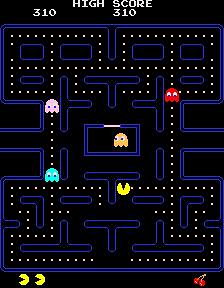
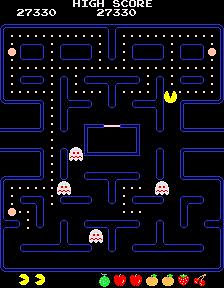
A piece of the pie
The notion of computer game superstars sharply divides between those that make the games, and those that are in the games – those who play the games, stand little chance of fame, although even gamers have their celebrities such as Threst, the champion Quake II player. In this sense, we are back to the film analogy; those who make and star gain celebrity, those who watch merely enjoy. Right from its early, blocky beginnings, the industry was able to generate huge amounts of income from creating a character, the first of which was Pac-Man, which continues even today, long after the craze emerged. There are now huge online archives devoted to documenting and wholesaling the merchandise of the Pac-Man and his sequels. There were even strange albums made such as Buckner and Garcia’s Pac-Man Fever, and, in 1981, How to win at Pac-Man was on the bestseller list. In creating Pac-Man, and subsequently a range of characters around him, Namco and Atari were able to tie together an incredibly lucrative string of titles, for an ever increasing (at the time) range of fragile computer platforms.
The idea was simple, as this excerpt from the original Midway arcade manual suggests: ‘The player, using a single-handle control, guides the Pac-Man about the maze, scoring points by munching up the dots in his path. Four ghost monsters – Inky, Blinky, Pinky and Clyde – chase after the Pac-Man trying to capture and deflate him. The Pac-Man can counterattack by eating the big, power capsule that enables him to overpower the monsters for additional score. After all the dots are gobbled up, the screen is cleared, and Pac-Man continues for another round. Each rack features a special fruit target in the maze, which if eaten, earns bonus points. Players start with three Pac-Men. An additional Pac-Man is awarded for 10,000 points.’ The historical role to usher in the forthcoming era of the video arcade was played by a circle with a pie-shaped cut in the middle, named after the Japanese word to eat (paku). He was, naturally, soon overshadowed by the newer, more advanced models for whom he had paved the way – such as QBert, Joust, Defender or the first virtual James Bond – Spyhunter. Going further back, one Internet Pac-archive claims to have uncovered the inspiration for the character. Few may remember the ill-fated Milton and Bradley game of the late 1970s known as Mr. Mouth. This was one of those large, battery operated games geared towards young children suffering from motor skills deficit syndrome. The game consisted of a yellow, spherical, Pac-Man-like creature (however heavily browed and googly eyed) with a continually opening and closing mouth as the centre piece. Radiating out from this were four, spring loaded arms at twelve, three, six and nine o’clock. The object of the game was to launch coloured chips from the spring-loaded arms into the ever opening and closing mouth of Mr. Mouth.
Pac-Man, of course, needs little introduction and the various versions continue to be released – now for an audience cashing in on the arcade nostalgia trend. Few characters have come close to Pac-Man’s early dominance, but it would be fair to say that Nintendo’s Super Mario Brothers has outstripped its original success many times over. Author J.C. Herz describes the phenomenon as ‘Mario über Alles’, but equates Nintendo’s use of licensing as a ruthless attempt to align themselves with Disney – creating a set of characters which can be applied to every possible facet of merchandising. A recent survey suggested that in five years’ time, Mario could be better known than Mickey Mouse.
From initial 2D adventures, the portly Italian plumber has exploded onto the 3D market, breaking new ground with every title. Developers are now moving pace with Mario. Once again, Dave McComb describes this in terms of the puzzles Mario has to solve as being symptomatic of the technology’s as well as the game’s progression: ‘… in moving to 3D, developers have had to overcome massive problems and think of innovative structures for their games. In 2D Mario games, the action was generally restricted to a scrolling horizontal plane and designers could position monsters and meanies in such a way that they had to be tackled by the Italian plumber … in the 3D world of SuperMario 64, things are different. The designers had to think of new ways to set dangers and tasks for their hero, and clever devices to force players to tackle specific problems and villains. Given the 3D nature of the game, players can simply walk around many of the puzzles, rather than being forced to face a problem head-on. The 3D nature of Super Mario 64 gave rise to the game’s interesting non-linear structure, players being able to choose the order in which they tackled missions, rather than having to play the game in a way predetermined by the coders.’
Celebrity coders
Mirrored by the celebrity of those characters in the game, is the celebrity of those who create the games themselves. One case in particular sticks out, especially for those of us who grew up with the zx Spectrum – that of Matthew Smith, creator of Manic Miner and Jet Set Willy, two of the most popular and commercially successful games of the home computer boom of the early 1980s. Even though he claimed that his most successful games were pale imitations of another Spectrum classic, his games became incredibly successful during the boom of 1983. All of this before he was twenty. Now he has disappeared into obscurity, so obviously fans of these games are curious to know what he is up to these days, and if he has produced any more modern-day masterpieces. Yet there is an obscure cloak of conspiracy built up around Matthew Smith. In fact, it was never proved that his picture was actually published, and he never showed himself in public as the one who wrote those two games. There are, however, some photographs that were published in 1984, which claim to show Matthew at work. There were even rumours that he did not actually exist, and that Matthew Smith was merely a code name for a Tandy computer, on which Miner Willy was born.
This creation of celebrity, or anti-celebrity to the point of notoriety, is by far more intriguing than the fame generated by the likes of the buxom Lara Croft. But of course, the superstars will inevitably go on to bigger and better things each time – there has already been a Mario movie, with Bob Hoskins in the lead role, and another film is in production, yet, much to my disappointment, I don’t foresee a film being made about the likes of Matthew Smith and his creation, Miner Willy. Back in 1984, Matthew Smith argued: ‘Things get hairy when we get machines which are more intelligent than us … what I don’t like about certain games is they’re not a simulation of any kind of real problem. I’m not into simulated violence. It’s not really that much fun.’
So, where might the future of computer games, the arcades in particular, lie when the visualisation of virtual violence becomes commercially unpopular and no longer viable? Or what about some kind of alternative to the navigation of an environment, real or imagined, which bears no relation any longer to simulated reality?
With the rise of the home market, the idea of having to die to end the game has become less compulsory, and other ‘closures’ are now being explored in a variety of interesting ways, mainly with the release of environmental constructions such as SimCity or Constructor. Such games would never be able to exist in arcade format. On the home market there had always been adventure games, which (I would argue) grew out of the Dungeons and Dragons craze of the mid- to late-1970s. Memorable home titles such as Colossal Adventure or Sphinx Adventure on the BBC Micro, were purely text-based (‘you are in a forest – exits are west and north’), though the Spectrum’s The Hobbit, added crude graphics. When it comes to immersing yourself into a virtual world almost completely (where death is almost impossible), it is difficult to surpass Cyan software’s beautifully contemplative Myst, and its sequel Riven. When comparing the genres of cinema and computer games, author J.C. Herz equates Myst with the films of D.W. Griffith (she also notably aligns those who scare themselves to death playing Doom multiplayers with fans of the films of Alfred Hitchcock). Myst, excelling in both sweep and style, expands upon many elements that had always seemed essential to video games, most notably, the skills of the player’s reflexes. At the time, it was a complete break from anything that was available. Whilst on the one hand almost cheating the ‘computer death’ issue by the fact that there was no real end to the game, the notion of becoming completely involved within a virtual environment, and not having to kill things, jump over things, or battle against the clock was a complete revelation. The players were now allowed to sit back and reflect upon their predicament, and work out what they had to do, rather than pound the keyboard in the race against time. This idea not only made the game much longer in terms of the time taken to complete it, but would occupy the player whilst not playing, torturing them with mind bending puzzles, for which there seemed no solution (or was there?). The experience completely took over the hardened Myst player. As with Pac-Man, the mapping of Myst’s intricacies has given rise to a plethora of Internet sites which detail the exact location of many of the objects, and instruct the lazy gamer how to complete the game in the quickest way. Like any old game, the computer game always had its nemesis – the infamous cheat mode.
Matthew Shadbolt, designer, London
Eye is the world’s most beautiful and collectable graphic design journal, published quarterly for professional designers, students and anyone interested in critical, informed writing about graphic design and visual culture. It is available from all good design bookshops and online at the Eye shop, where you can buy subscriptions, back issues and single copies of the latest issue. You can also browse visual samples of recent issues at Eye before You Buy.

